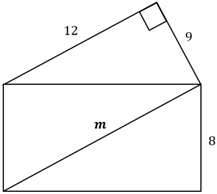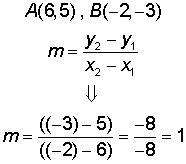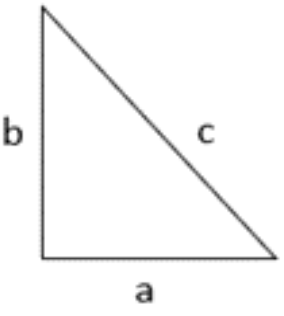The Postsecondary Education Readiness Test (PERT test) assesses a student's preparedness for college-level coursework in Florida. This test aids academic institutions in placing students into appropriate courses. It doesn't have a formal score but is adaptive, meaning the difficulty increases with each correct answer, which then influences the level of courses assigned. The test comprises 90 questions, with no time limit, and is divided into three sections: Mathematics, Writing, and Reading.
On this PERT practice test, we will cover different examples of questions from the test and its sections, including detailed explanations and solving tips – to help you better understand the nature of the exam. Continue below to start practicing, as we will begin with math.
 PERT Math Practice Test Questions
PERT Math Practice Test Questions
The PERT Math section includes 30 questions which vary in difficulty according to your success in previous questions. The main subjects in the section are Equations, Algebraic Expressions, Polynomials, Coordinate Planes, etc. Let's begin reviewing different questions in the section.
PERT Test Math Question #1
What is the equation of a line which cross the points: A(6,5) and B(-2,-3)?
PERT Test Math Question #2
Use the image of the triangle and rectangle below to answer the question.

What is the length of the rectangle's diagonal (m)?
More PERT Math Practice Tests
Remember, calculators are not permitted in the real test! Make sure you are prepared to solve the math problems to the best of your ability.
The best way to prepare for your upcoming exam is to familiarize yourself with the exam format and questions. On our PERT Test PrepPack you will be able to access hundreds of sample questions with detailed explanations, as well as realistic simulations and expert tips.
PERT Test Math Question #3
Sarah wants to build eight identical wooden chairs for the new dinner table in her house. One pound of wood costs three and a half dollars. She uses sixteen and a half pounds to build three chairs.
How much will it cost her to build all the chairs she wants?
PERT Test Math Question #4
Look at the scores of the final English exam:
What is David's score, if the mean is 75?
PERT Math Tip – Master the basics
While there are quite a few quick and effective solving techniques – none replace the importance of knowing the basic mathematic principles. In the question above, using Pythagoras's Equation is essential, as well as the geometrical understanding of the characteristics of a rectangle.
 PERT Reading Practice Test Questions
PERT Reading Practice Test Questions
The PERT Reading section includes 30 questions which vary in difficulty according to your success in previous questions. The main subjects in the section are Summarization, Determining the Meaning of Words in Context, Recognizing Relationships of Sentences, Distinguishing Facts and Opinions, etc. You will be presented with a text, followed by one question or more. Let's begin reviewing different questions in the section.
PERT Test Reading Question #5
Antonio Vivaldi was an 18th century Italian composer, violinist, teacher, and Catholic priest. He is recognized as one of the greatest Baroque composers, and his influence during his lifetime was widespread across Europe.
He is known mainly for composing many instrumental concertos for the violin and a variety of other instruments, as well as more than forty operas. His best-known work is a series of violin concertos known as The Four Seasons. Despite his prolific career, Vivaldi died in poverty.
From this passage, one may conclude that Vivaldi ______
PERT Test Reading Question #6
Little benefit is expected from climate change, but scientists have found at least one species that seems to be better off in a rapidly warming world. The Brown Argus butterfly has increased its range in England northward by about 50 miles over the past two decades. While not unexpected—many species have already responded to recent warming by moving—what makes the Brown Argus butterfly different is that the change in range has actually benefited the species.
In its caterpillar form, the Brown Argus feeds off wild geranium plants, but only in warmer summers—which is exactly what’s been happening in England and much of the rest of the world thanks to climate change. Over the past 20 years, the Brown Argus, which was considered scarce in the 1980s, has spread northward and now flourishes in much of southern England.
As David Roy of the Centre for Ecology and Hydrology in the U.K. put it, "The change in diet represents a change to the interactions between species—in this case between a butterfly and the plants that its caterpillars eat—caused by climate warming. Changes to the interactions between species are often predicted to alter the rate at which species shift their distribution in response to climate change; and now we have demonstrated this in nature."
But the Brown Argus butterfly is likely to be the exception to climate change, not the rule. Past periods of sudden climate change in the earth’s history have led to a reduction in biodiversity and even great extinction waves. If warming keeps up at the expected rate—and we’re doing little to slow it down—far more species will suffer.
On the other hand, mostly in regard to mourning days initiated by the people, such as the day of Princess Diana’s funeral in the UK, they reflect a spontaneous bout of pure grief, sometimes manifested in the closing of shops and banks and the cancellation of sports and theater and cinema showings.
Which of the following sentences contains an opinion?
PERT Reading Tip – Read the questions first
This tip is probably more useful with a narrow time limit – but it is still quite useful in every reading question – either short or long. The basic is, that when you read the whole text first and then the question – you may be distracted and confused from the information you had just read. By starting from the question – you can continue to read the text, but this time with a knowledge of what you are looking for, different clues in the text can easily provide the answer. Continue below and attempt to use this tip for the following questions regarding the text above.
PERT Test Reading Question #7
Answer the following question according to the passage above.
Which of the following statements best encompasses the main idea of the passage?
PERT Test Reading Question #8
Which of the following best describes the text structure of the first paragraph?
More PERT Reading Practice Tests
Get more practice questions and comprehensive explanations with our PERT Test PrepPack. Enhance your reading skills with test simulations and specified quizzes to improve your skills in vocabulary, sentence relationships, short and long paragraphs, long texts, and literature.
Secure your 12-month license with only $79!
While the PERT Reading section tests a variety of comprehension, critical, and verbal skills – all the questions are related to different texts. Therefore, it is essential to read, a lot, ahead of your test. Let's continue to the final section of the PERT – the Writing section.
 PERT Writing Practice Test Questions
PERT Writing Practice Test Questions
The PERT Writing section includes 30 questions which vary in difficulty according to your success in previous questions. The main subjects in the section are Sustaining and Establishing Topics, Use of Conventions of Standard Written English, Conveying Complex Information, Word Choice Skills, Grammar, Spelling, Punctuation, etc. Let's begin reviewing different questions in the section.
PERT Test Writing Question #9
Which of the following sentences is grammatically correct?
PERT Test Writing Question #10
Which of the following sentences includes an example of vague pronoun use?
PERT Writing Tips:
- Check for Common Errors: Watch out for common grammatical errors such as incorrect verb forms, misplaced modifiers, and incorrect pronoun use. For example, "Here is the books you were looking for all morning" is incorrect because "books" (plural subject) should be paired with "are" instead of "is."
- Simplify Complex Sentences: Break down complex sentences into simpler parts to check for grammatical correctness. This helps in identifying errors more easily. For example, in the sentence "It isn’t wise to have a tank of fish without a filter because it will get dirty," consider what "it" refers to and whether the sentence structure conveys the intended meaning.
Next are additional questions like in the PERT Writing section, where you can practice those tips and find additional explanations.
PERT Test Writing Question #11
Which title of a work of art is capitalized correctly?
PERT Test Writing Question #12
Choose the word that is spelled correctly.
More PERT Writing Practice Tests
Practice questions in the format of the writing section of the PERT Test to be fully prepared! Our PrepPack includes two full-length simulations that will help you practice all different difficulty levels of the test. The PERT Practice Pack covers all three sections of the test. All the questions and simulations in our pack follow the same format as the PERT Test.
 More About the PERT Test
More About the PERT Test
- The PERT Test is not a pass/fail assessment. Rather, the results will determine student's placements in college courses.
- The test is not timed but must be completed the day you start.
- Depending on the college you're applying to, you might be allowed up to 3 attempts to take and improve your scores on the PERT Test.
- Some colleges offer on-campus testing while in other cases you will have undergo virtual testing. Either way, the PERT Test will be the same.
 What PERT Scores Do You Need to Pass?
What PERT Scores Do You Need to Pass?
The Postsecondary Education Readiness Test (PERT) doesn't have a traditional "pass" or "fail" scoring system. Instead, it's used to determine your current academic skill level, particularly in Mathematics, Reading, and Writing, to place you in the appropriate college courses.
However, there are specific placement test score thresholds that indicate college readiness. These scores are not based solely on your success in the test but are based on percentiles of how you succeeded compared to other test-takers, normalized so different test forms can be compared. Here's a general idea of what this score range usually looks like:
- Mathematics: A score of around 113 or higher typically indicates readiness for college-level math courses (about 21%).
- Reading: A score of approximately 106 or higher generally suggests readiness for college-level reading assignments (about 42%).
- Writing: A score in the vicinity of 103 or higher is often considered indicative of college-level writing skills (about 55%).
These scores can vary slightly depending on the institution. It's important to check with the specific college or university you're interested in attending for their score requirements. Remember, if your scores are below these thresholds, it usually means you'll be placed in developmental courses to improve your skills before taking on college-level work (that means, for example, that a great majority of the students will take developmental mathematical courses).
 PERT Testing FAQ's
PERT Testing FAQ's
The Postsecondary Education Readiness Test (PERT Test) is an assessment used by academic institutions in Florida to evaluate a student's readiness for college-level coursework. Unlike traditional tests, the PERT is adaptive, adjusting the difficulty of questions based on the student's performance as they progress. This helps determine the most suitable level of coursework for each student. The test consists of 90 questions across three sections: Mathematics, Writing, and Reading, and it is untimed, allowing students to work at their own pace. The PERT does not have a formal score, but the results play a crucial role in course placement.
Calculators are not generally allowed. The test is designed in a way that the math problems can be solved without a calculator.
However, for certain math questions, a pop-up calculator is provided on the computer screen within the test interface.
This means that when you take the PERT you can use this on-screen calculator for specific questions where it's deemed necessary, but you cannot bring your own calculator into the test.
The Postsecondary Education Readiness Test (PERT) is untimed, allowing test-takers to work through the questions at their own pace.
However, the average time to complete the test is usually around three hours.









